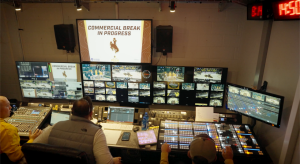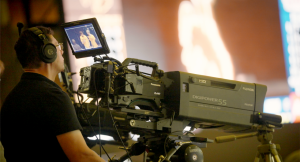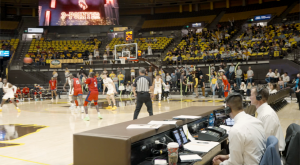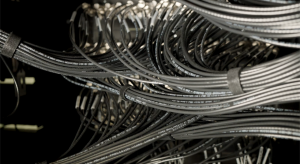Key Code Media Performs Upgrades to University of Wyoming Athletics’ Control Room, Camera Systems
Story Highlights
Key Code Media recently upgraded the University of Wyoming Athletics sports video facility located on the campus in Laramie, WY. The upgraded system supports video board and video streaming for university football, basketball, volleyball, and soccer games. Although built primarily for in-house production, the upgraded facility is capable of network-quality sports television production.
The project included an extensive upgrade to the control room technical core, monitor wall, graphics, replay systems, audio and intercom systems. Key Code Media provided a turnkey solution, installation, and training for the project.
The challenges of the project included working with wide-area signal paths, reverse engineering parts of the system, and completing the project within a limited time window.
Dennis Trapani is the Associate Athletics Director, Creative Services and has a long history of working with Key Code Media on sourcing equipment for their station.
“This past summer we took a step back and realized some of our equipment needed to be replaced,” he says. “We had an opportunity to expand our capabilities with systems that are easier to use, as well as more flexible IP workflows. That’s when we called our friends at Key Code Media.”
Control Room Upgrade Included NDI-Ready TriCaster 2 Elite, Ross Xpression, and Ross Mira Replay System
The heart of the technical core is a Ross Ultrix 62 x 62 router and a Newtek TriCaster 2 Elite supporting a 1080i video standard. The Ross Ultrix router is a compact five rack unit design utilizing high-density HD-BNC connectors. Existing Ross router control panels could be reused with the Ultrix. All control room HD-SDI video system sources and destinations passed through the Ultrix router.
The Newtek Tricaster 2 Elite provided switching and signal processing support for the HD-SDI and NDI sources. Each of the eight Tricaster HD-SDI inputs has a frame synchronizer. The unit has eight HD-SDI outputs and four DP/HDMI monitor outputs. The monitor outputs provide multiviewer support to four new Samsung monitors.
Other new Ross products included a Ross Xpression graphics system delivering signal in NDI format and an eight channel Ross Mira, two-operator replay system.
“The Ross Xpression has been one of the biggest game-changers for us,” adds Trapani. “The ability to read XML files, automatically populate graphics and the ease of use of the operating system. Now we can have a student operate graphics, removing the need to outsource a professional.”
Several program feeds are created for distribution; these feeds are typically created and formatted in the Tricaster 2. Here is a breakdown of the video feeds the UW Athletic team are using:
- A full 1080i feed that goes to the broadcast encoder for streaming and LTN for linear broadcast. This feed is controlled by a built-in macro to put an “in commercial” slate up during the broadcast.
- A 720p clean feed for the in-venue, video board show. This feed also goes to the in-house cable system for concourse television.
- A 1080i feed for booth talent including program and preview.
- A 1080i program feed for the commercial coordinator.
- A basketball coach’s feed from a Tricaster M/E, comprised of the game camera and score bug.
MultiDyne Fiber Connected Panasonic Cameras
The sports venues were wired with legacy fiber and the video and camera signals were routed in a fiber optic patch bay located in the control room. Cameras were located in the venues, but most of the production equipment and control are located in the control room.
The legacy Panasonic cameras utilized MultiDyne Silverback II camera modules communicating with MultiDyne Silverback II multiplex base stations (CCU) via single-mode fiber optical cable; the base stations were located in the control room racks at the video engineering position.
Marshall POV cameras were used in key areas such as basketball net cameras.
A Tuned-Up Audio and Comm Systems
Audio for the control is routed through the Ross Ultrix router using a MADI interface via the Ultrix SFP port. MADI is sent to the Mamba ANMA64 and MADILEXTN converters. From there, the analog audio is distributed around the control room via audio patch panels for fast setups and workarounds.
The legacy intercom system was problematic. By redesigning and rewiring parts of the system and “tuning” the Clearcom hybrids, better audio quality was achieved. 4-wire intercom audio was sent to and from the football stadium over a single-mode fiber transceiver.
The majority of the audio equipment was located in the control room with a booth, effects audio, intercom, and IFB located in the venues. Both copper tie lines and fiber were used to connect these devices to the control room.
Systems Integration by the Key Code Media Team
The project was designed in the Seattle and Denver offices of Key Code Media. Installation took place on campus in Laramie, Wyoming, followed by systems testing and commissioning. Following Key Code best practices, a full design package was created and each newly installed cable was labeled with a unique number.
Ross provided remote commissioning support for the Ultrix, Xpression, and Mira. The campus Information Technology department assisted in the configuration of equipment networks, adhering to strict campus security standards. Key Code also provided on-site technical support during the first few games of the football season.
With higher demand for video streaming of athletic events, universities are increasing and improving their video production systems. From consulting to design to construction, Key Code Media provides a full range of services for custom media facilities.




